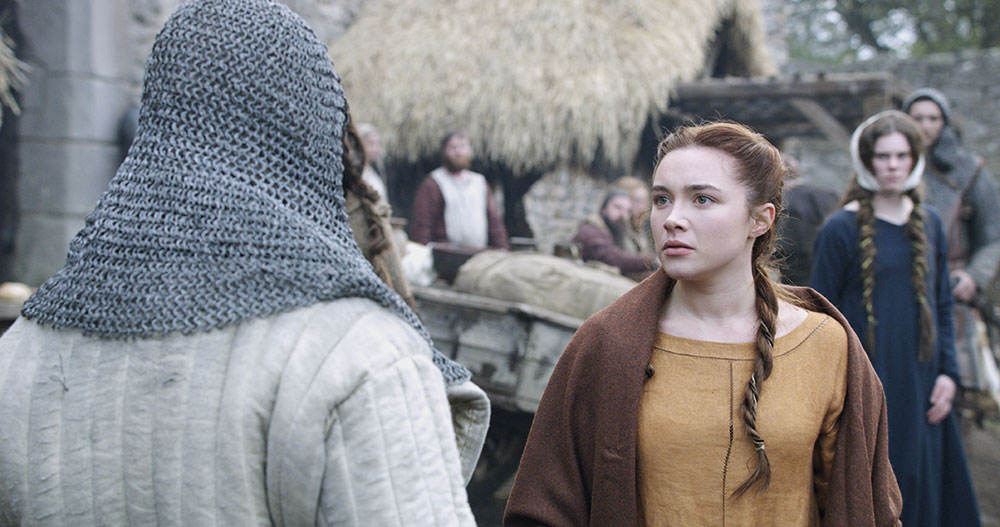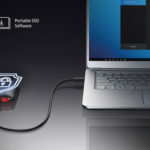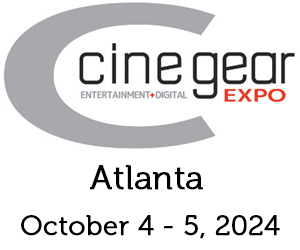
Data Freedom!
Posted on Jan 2, 2019 by Julian Mitchell

words Julian Mitchell / pictures Netflix
Netflix movie Outlaw King follows Scotland’s Robert the Bruce and his escapades against the old enemy – but the real capture story was the data
Outlaw King is the untold true story of Robert the Bruce, who transforms from defeated nobleman to outlaw hero during the oppressive occupation of medieval Scotland by Edward I of England.
Data specialists The Digital Orchard provided on-set DIT, lab services and video playback services for the film, which was shot last year in the late summer in midge-ridden Scotland – and its unpredictable weather. Sam Spurgeon from Digital Orchard explained the plan. “The director, David Mackenzie, and DOP Barry Ackroyd had agreed that they would always shoot through the ever-changing Scottish weather and not be waiting for cloud cover and the like. In terms of how hard it was I think the weather was certainly on our side, and I think some of the battles were even muddied up to make them feel a bit grittier than they were, although the midges at the end of August were particularly bad. It definitely wasn’t without its cold and wet days, and some of the more remote shooting locations meant four a.m. starts.”
The main cameras were Panavision’s DXL1 as A, B and D, with a stripped-down RED Weapon as their C camera for use on specialist rigs like wire cam and Stabileye. There was a second RED Weapon as the E camera. On aerial unit days this set would be complemented by either an extra RED Weapon or ARRI Alexa Mini for drone or helicopter work. The DXL1 was used on the Steadicam rig as well.
 Director David Mackenzie inspects the troops during filming.
Director David Mackenzie inspects the troops during filming.
“Second unit was with cameras D and E, which were one DXL and one Weapon. Aerial units had a mix of cameras, including an Alexa Mini and another RED. I think the most cameras were seven including another DXL, which came out for a Russian arm and for stunt sequences. Panavision were very helpful to us, especially when they knew we were shooting half way up the side of a mountain. They were great at helping problem-solve and getting us everything we needed, which included changing out battery hotswaps and SDI boards on the DXLs for upgraded versions.
“Our other kit consisted of Blackmagic Design Smart Videohubs, Sony 17in OLED monitors, Apple MacBooks, Fujifilm IS-Mini LUT boxes, Tangent Ripple grading panels and Odyssey 7Q+ monitors (these monitors were the real workhorses of the show and featured on all the various rigs we ended up using). They were mounted on a number of different rigs, from a simple C stand to a cart with a low centre of gravity equipped with large, off-road wheels.
8K heaven
All these cameras, apart from the Alexa Mini, were capable of shooting 8K so that is six possible 8K cameras churning out data in the middle of the Scottish countryside. “There was a lot of 8K, but a lot of A camera stuff was shot around 5K so it was a mix of resolutions – but on the whole it was lots of data. A lot of cameras were turning over a lot of the time and what made this shoot particularly challenging was that our director had a desire to be able to edit what he saw that day, straight after we had wrapped.
“We shot at a lot of remote locations, protected sites and other areas that presented their own unique challenges. As a result, our on-set kit had to be fairly flexible depending on what was needed that day. It ranged from a full LiveGrade set-up with calibrated OLED monitors, waveforms, switchers and LUT boxes, right down to a skeleton set-up comprising battery powered Odysseys and IRIS handsets.
3D scanning for Outlaw

Lidar Lounge did all of the 3D scanning for Outlaw King. They used their cyberscanning photogrammetry rig to create 3D models of all the actors and hundreds of background extras (see pictures) as well as lots of horses and dogs, too. This was used for the big battle scenes in the film to replicate vast armies. Their cyberscanning rig was set up in a marquee in the middle of the Scottish Highlands – during which there happened to be a hurricane visiting the UK. The team spent the whole night holding down the rig to make sure that it didn’t get blown away.
They also did all of the set scanning, processing everything from huge environments, towns to castles and trebuchets, all during winter in Glasgow, so it was intense work. The Lidar was used for tracking the shots, building CG environments and for making now-ruined castles look as they would have done back in their heyday.
“We offered as many services as the locations would allow us to. Some places required us to drive through rivers in 4x4s and then hike up mountains in bad weather conditions, so these tended to be serviced by a paired-down solution, but some of the buildings we filmed at were more accessible, and allowed us to wheel bigger rigs onto set.”
Pipeline
The dailies pipeline was unique, due to the director’s wish to edit each day’s material at the end of the day – and there was a lot of data with so many cameras shooting. “Having a near-set lab and up to five daily rushes runs to the editorial department helped facilitate the process, as well as Jo Barker, the lab manager, being able to turn around quality dailies grades very quickly. The Raw compression scheme offered by the DXLs and REDs meant that 8K offload times weren’t as time-consuming as they could have been, and RED Rocket cards sped up the transcode process for us, too.

“So we were trying to combine achieving that as well as working in this crazy remote location – it was quite a tall order, which we fulfilled by having constant rushes drivers taking drives to the edit; as soon as we got our cards in, they would be transcoded and sent off straight away rather than the usual split at lunchtime type of rule. That was one of the ways we did it, but that still didn’t get round crunching all the data – we had separate data stations, so we had two people in our lab downloading.
“The other wrinkle was that Netflix didn’t allow us to create dailies from proxy files. The Weapon and DXL do shoot proxies, which would have been great as you can just take the cards out, get the transcodes done and then get them to the edit really quickly. But because of QC implications they don’t allow it, so you have to download the full 8K. I think what we ended up doing was a drag and drop copy just to get it over as quickly as possible, then coloured and transcoded. Then the card would go off to the other station for the full verified offload, which would take time.

“The lab was in the back of a truck. Because the turnarounds were so quick and the locations so remote, it was too difficult to split the camera and the lab so we had at least two data managers working in the back of a truck the whole time, which I know for them was difficult in terms of power. We tried at one point satellite and Internet transfer to get that back to the edit but it was never fast enough in our remote location in Scotland.
Sometimes the editor would even take a copy of the project on his laptop and come and join us because we would be too far from a proper edit facility to make this kind of workflow feasible.”
Camera settings
“On set we managed the camera set-ups and problem resolution with the firmware we were using, as well as setting exposure through iris control, neutral density filters and camera sensitivity settings. A show LUT was applied to monitor feeds and where locations allowed this image was further finessed through live grading. Barry’s ideas for the look of the dailies were fed through the lab via written and verbal notes to keep consistency with days when live grading was not possible (rather than CDLs). Stills were then fed back to set for his approval.”
At the near-set lab, sound was synced with the Raw footage and dailies for editorial and PIX online rushes system were created using the show LUT and Jo Barker’s primary grade. The CDLs from this grade for each shot would then travel down the colour pipeline to editorial via ALE and then on to the final grade/VFX to use as a starting point for their work.
 Video playback operator James Edgcombe and DIT Sam Spurgeon set up for a shot at Glasgow Cathedral.
Video playback operator James Edgcombe and DIT Sam Spurgeon set up for a shot at Glasgow Cathedral.
“In terms of colour, Barry was great. We would live grade where we could, obviously exposure monitoring, but then every day we would look at the day and decide what package we were taking out. Sometimes this was an Odyssey recorder on a stick. It was very much a modular approach in terms of how we worked.”
David Mackenzie liked to keep the cameras rolling, which of course resulted in a great deal of footage. “David wanted this constant flow – keeping the cameras going kept the energy high with the actors and because of that there were quite a lot of rolling re-sets, which perhaps made things more complicated for us with things such as metadata.
“We had to be particularly verbose in the comments; our philosophy was that everything we did, like colour values and QC, for example, travelled down to editorial and on to the final DI. The fact that we had that knowledge of, say, five takes on one clip, would travel down to them and hopefully make their job a little bit easier. We were also not allowed to slate, which became a cataloguing nightmare. I think towards the end we did review the slating, there was no script supervisor and we did it without a continuity person, too. It just emphasises how important it is at the lab stage that all the information is maintained and enabled to be communicated very clearly through the metadata, and through the colour pipeline, basically.
“We work out our data requirements on a worst-case scenario. We’d look at how many cameras they had out there – we knew the schedule was ten-hour days so we could have up to four or five hours per camera per day. As long as you factor that then anything less than that was an easy day, or an easier day. We never wanted the lab to have nothing – if the lab was doing nothing then we’d reload. We tried to minimize that downtime as much as possible to mediate the data management better.”
The Outlaw look
“We tended not to deviate from shooting at a colour temperature of 4800 Kelvin. This cooled our exteriors and combined with a slightly desaturated show LUT gave them a gritty feel to complement the (not always) bad weather. Indoors, it provided a balance for mixed source exterior daylight (or daylight fixtures) and interior fires, candles and other warmer sources. In live grading, we’d enhance this further by adding mood through contrast and black levels as well as any colour balancing that was required.
“As mentioned above, we adapted the rigs we took out depending on the location for that day. The Odyssey 7Q+ was always central to whatever rig we took as it provides so much functionality in a portable unit. Remote locations, small power boats and SSSI-protected locations are a few examples of where its small footprint really came into its own, allowing us to be very nimble and move from location to location very easily. When we got the chance to bring and use more kit, we added monitors, live grading functions and so on.

“Our daily approach was to take what we thought we’d need for that day from our 18-ton truck, load it into a 4×4, which we’d drive as far as we could before decanting a subset of that kit into Foldit carts that we’d take the rest of the way. This allowed us to get the right kit for the job into some pretty remote places.”
Memorable scene
One of the film’s most significant and dramatic scenes is the battle of Loudoun Hill. “It was a long, wet shoot with lots of stunts and great set pieces – I’m looking forward to seeing how all the work that went into it turns out. The second unit shot a lot of wire cam work, which we didn’t get to do on main unit, so I’m interested to see how that all looks, too.”






















